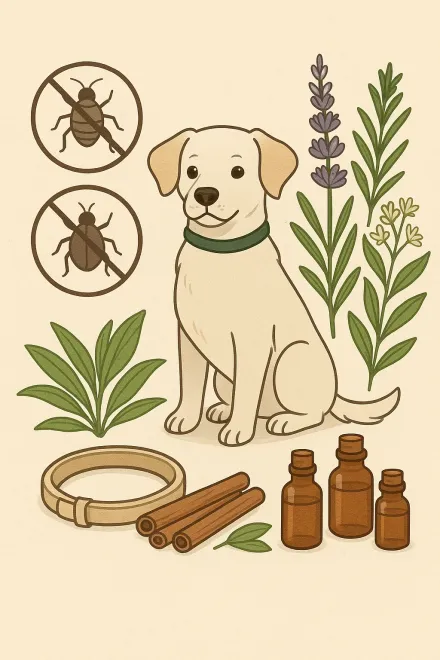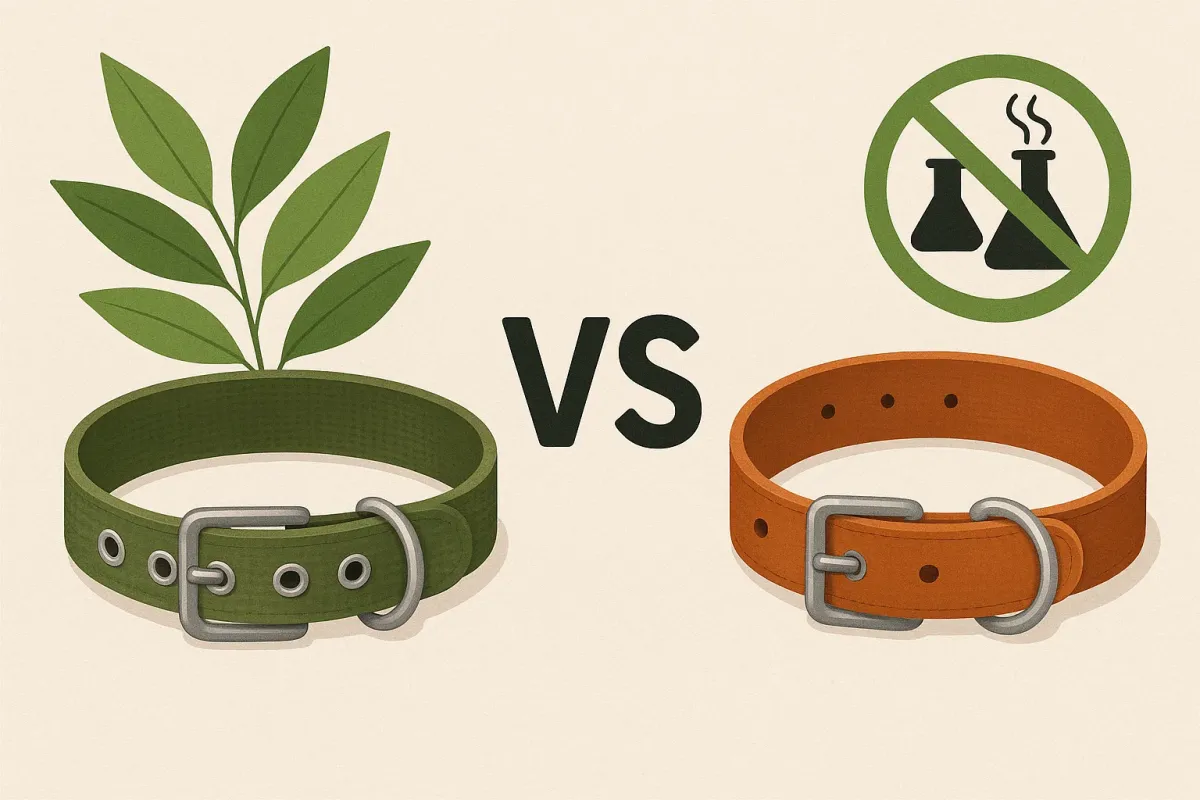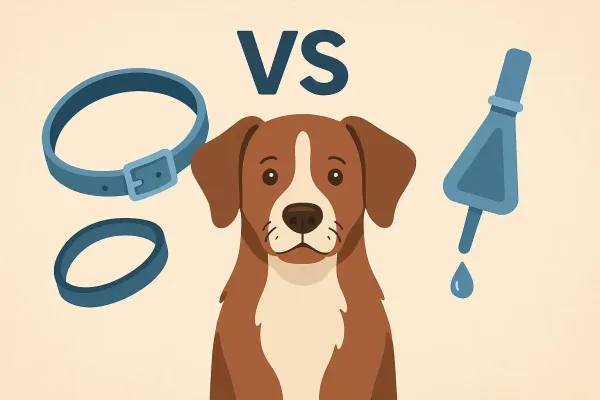
Choosing the best method to protect your dog from fleas and ticks isn’t always easy. The market offers both natural flea & tick collars and chemical collars, each with different features, effectiveness, and safety profiles.
In this guide, we take a deep look at the advantages and disadvantages of natural and chemical antiparasitic collars to help you decide what’s best based on your dog’s needs, environment, and sensitivity to certain ingredients.
What’s the difference between a natural and a chemical flea & tick collar?
Natural antiparasitic collars and chemical collars share the same goal: protecting your dog against fleas, ticks, and other external parasites. However, they differ in the ingredients they use and in how they act on the animal’s body.
Natural collars use essential oils and plant extracts with repellent properties, such as eucalyptus, citronella, lavender, or neem. These components create a scent and a protective film on the dog’s skin that drives parasites away, preventing them from attaching or biting. They don’t kill parasites already on the animal, but they do prevent new infestations in a gentle, safe way.
Chemical flea & tick collars, on the other hand, contain synthetic insecticides or repellents like flumethrin, imidacloprid, or deltamethrin. These compounds act more powerfully: they not only repel parasites but also eliminate them when they come into contact with the dog’s coat or skin. Their effect spreads evenly thanks to the dog’s natural sebum, providing continuous protection for several months.
In short, natural collars offer a more gentle, eco-friendly, and safe option for sensitive dogs or puppies, while chemical collars stand out for their effectiveness and longevity, making them the top choice in areas with high parasite presence or during peak-risk months.

Advantages of natural flea & tick collars
Natural flea & tick collars have become a popular alternative for owners seeking safer options that respect both their dog’s health and the environment. Their formulas based on essential oils and plant extracts help repel fleas and ticks without resorting to harsh chemicals.
Among their main advantages is the absence of toxic pesticides, which makes them especially suitable for small dogs, puppies, and animals with sensitive skin or dermatologic allergies. Since they don’t contain insecticides, they reduce the risk of irritation and are safer in households with children or multiple pets.
They also release a pleasant natural scent thanks to oils like citronella, lavender, or neem, which offer a calming effect and keep the coat smelling fresh. Their natural composition also makes it easier to combine the collar with other antiparasitic treatments—like shampoos or sprays—without harmful interactions.
- No synthetic chemicals or pesticides.
- Suitable for sensitive dogs, puppies, and pregnant females.
- Natural, pleasant scent for the home.
- Can be combined with other antiparasitic methods.
- Lower risk of side effects or allergic reactions.
All in all, natural collars provide gentle, respectful protection ideal for dogs living in urban environments or with low parasite exposure, ensuring well-being without compromising health.
Disadvantages of natural flea & tick collars
Although natural flea & tick collars are safer and more eco-friendly, they do have some important limitations to consider before choosing them. Their main drawback is that their effectiveness may be lower against heavy infestations or in environments with a high presence of fleas and ticks.
The duration of protection also tends to be shorter—generally between 1 and 3 months—because essential oils evaporate over time or wash off with water. For this reason, they aren’t the best choice for dogs that bathe frequently or live in rural areas with many parasites. In addition, their effect is mainly preventive: they repel insects but do not eliminate those already present on the animal.
- Shorter lifespan compared to chemical collars.
- Less effective protection in high-parasite areas.
- Effectiveness drops if the dog often gets wet.
- Do not resolve existing infestations.
- Require more frequent replacement to maintain efficacy.
In conclusion, natural collars are a good option for city dogs, puppies, or allergy-prone animals, but in high-risk scenarios or active infestations, a chemical collar—or a veterinarian-guided combination—may be more advisable.


Advantages of chemical flea & tick collars
Chemical flea & tick collars are the most widely used thanks to their high effectiveness and long-lasting protection. They’re formulated with active ingredients such as flumethrin, imidacloprid, or deltamethrin, which act directly against fleas, ticks, and other parasites—eliminating them before they can bite or transmit disease.
Their main advantage is that they offer continuous protection for up to 8 months, making them a practical, durable choice. Unlike natural collars, they not only repel but also kill parasites already present in the dog’s coat, providing both preventive and curative action.
Moreover, these collars are veterinarian-recommended in most cases, especially in rural areas or during peak parasite seasons. They are designed to resist water and wear, so your dog can bathe or get wet without losing effectiveness.
- High efficacy against fleas, ticks, and mosquitoes.
- Long-lasting protection—up to 8 months.
- Preventive and curative action.
- Recommended by veterinarians.
- Water- and wear-resistant.
- Easy to put on and low maintenance.
In summary, chemical collars are the best option for dogs living with high parasite exposure or for owners seeking complete, long-lasting protection with minimal effort.
Disadvantages of chemical flea & tick collars
Despite their many benefits, chemical flea & tick collars have certain drawbacks to consider before use. Since they contain synthetic insecticides or repellents, they may cause skin irritation or allergic reactions in dogs with sensitive skin.
Another factor to consider is the risk if the dog chews the collar, as it could ingest small amounts of the chemical product. For this reason, avoid them with young dogs prone to chewing or playing with their collar. Caution is also advised in households with small children, who might come into direct contact with the product when petting the dog.
Likewise, these collars are not suitable for very young puppies or for dogs with liver issues or diagnosed allergies, as the animal’s metabolism may not tolerate the active compounds well.
- Potential skin irritation or allergies.
- Not suitable for puppies or dogs with liver disease.
- Risk if the dog chews the collar.
- Caution in homes with small children.
- Not recommended for dogs with very sensitive skin.
In conclusion, chemical collars are highly effective but should be used with care and veterinary guidance, especially for sensitive dogs or in environments with children. Choosing the right model and fitting it correctly minimizes risks and ensures safe protection.

Conclusion: natural or chemical flea & tick collar?
After comparing natural flea & tick collars and chemical collars, it’s clear that both have advantages and limitations. There’s no universally “best” option—the choice depends on the dog, its environment, and the level of protection required.
Natural collars stand out for their safety, gentleness, and lack of toxic ingredients, making them ideal for puppies, indoor dogs, or those with sensitive skin. They offer adequate preventive protection in areas where infestation risk is low to moderate and are kinder to both the animal and the environment.
Chemical collars, on the other hand, offer more complete, longer-lasting protection, effective against fleas, ticks, and mosquitoes even in rural settings or during hot months. They’re veterinarian-recommended and the best alternative for active dogs or those with high parasite exposure.
Ultimately, if your dog lives mainly indoors or in urban environments, a natural collar may be more than enough. But if it spends lots of time outdoors or in areas with abundant parasites, a chemical collar will be the most effective option. The key is to match the choice to your dog’s lifestyle and health, always with veterinary guidance.
Which type of flea & tick collar to choose for your dog
Not all dogs need the same level of protection against fleas and ticks. The choice between a natural flea & tick collar and a chemical one should be tailored to factors like age, size, living environment, and skin sensitivity. Choosing correctly can mean the difference between effective protection and potential irritation or poor results.
Below you’ll find which type of collar is usually most suitable depending on your dog’s profile and lifestyle. This guide will help you identify the best fit for your pet and make an informed decision with your vet’s advice.
🐶 Puppies and young dogs
Puppies and growing dogs have more sensitive skin and developing immune systems. For them, natural flea & tick collars are the safest option because they don’t contain chemical insecticides and reduce the risk of skin reactions. Brands like Beaphar or Menforsan offer models specifically for early ages.
🐾 Dogs with allergies or sensitive skin
For dogs with dermatitis or allergies, natural collars made with essential oils such as lavender, neem, or citronella are the best choice. These ingredients help repel parasites without causing irritation and provide a pleasant aroma. In these cases, it’s advisable to avoid chemical collars.
🦮 Country dogs or those with high parasite exposure
Dogs that spend lots of time outdoors—in rural or wooded areas—need stronger protection. Chemical collars like Seresto or Scalibor are the most effective because they eliminate fleas, ticks, and mosquitoes for several months and resist water and dust.
🏙️ Urban or indoor dogs
Dogs that live mostly indoors or walk in urban areas face lower infestation risk. In these cases, either type of collar can work. A natural model will be enough to deter occasional parasites, while a chemical one provides longer protection with less upkeep.
🌊 Dogs that bathe frequently
If your dog loves water or bathes often, choose a water-resistant chemical collar such as those from Seresto or Taberdog. Natural collars lose effectiveness faster when wet and therefore require more frequent replacement.
👴🐕 Senior dogs or those with health issues
For senior dogs or those with liver problems, it’s better to opt for natural collars or gentle topical treatments. Avoid strong chemical products that could stress the body. In these cases, safety and comfort are the priority.
In short, natural collars are ideal for young, urban, or sensitive dogs, while chemical collars are preferable for country dogs or those with high parasite exposure. Choosing the right type based on your dog’s lifestyle and health will ensure effective, safe protection year-round.
Tips for using a flea & tick collar correctly
A flea & tick collar is only truly effective if used correctly. Proper fit, keeping it clean, and replacing it at the right time are key steps to ensure your dog stays protected all year. These tips will help you get the most from it and avoid common mistakes.
1. Fit and adjustment: the collar should be snug but not tight. Leave a two-finger gap between the dog’s neck and the collar for comfort and to prevent chafing. Trim any excess length—especially if your dog tends to chew it.
2. When to replace it: most chemical collars protect for 6–8 months, while natural collars last 1–3 months. Replace it as soon as effectiveness drops or the manufacturer’s indicated time has passed. Don’t reuse an old collar—the active ingredients degrade over time.
3. Precautions: avoid frequent bathing if your dog wears a natural collar, since water reduces its effectiveness. For chemical collars, make sure they’re water-resistant before letting your dog swim. If you have small children at home, prevent them from handling the collar directly. Also, don’t combine multiple antiparasitic products without your vet’s recommendation, as this could cause overdosing or skin irritation.
- Always read the manufacturer’s instructions before fitting.
- Don’t use flea & tick collars on puppies younger than the recommended age.
- Check your dog’s skin regularly for possible irritation.
- Keep the collar in its original packaging until use.
- Consult your veterinarian if you want to combine it with spot-ons or oral treatments.
By following these recommendations, your dog will enjoy safe, comfortable, and long-lasting protection. Responsible use of a flea & tick collar not only prevents infestations but also safeguards your pet’s health and well-being.
Practical tips for using a flea & tick collar correctly
Adjust the collar leaving a two-finger gap between the neck and the collar for a comfortable, safe fit.
Replace the collar once its effective period ends (6–8 months for chemical, 1–3 for natural).
Avoid frequent baths if the collar is natural; check that it’s water-resistant if it’s chemical.
If there are children at home, prevent them from handling the collar directly and wash your hands after fitting it.
Don’t combine multiple antiparasitic products without consulting your vet to avoid irritation or overdosing.
Conclusion: natural or chemical flea & tick collar?
Both natural flea & tick collars and chemical collars can provide effective protection against fleas, ticks, and other parasites—provided they’re used correctly and tailored to each dog’s needs. The key isn’t choosing the most popular option, but the one that best fits your dog’s lifestyle and condition.
Natural collars are ideal for sensitive, urban-living dogs and puppies, as they offer gentle protection with minimal risk of adverse reactions. Chemical collars, by contrast, are better suited to large dogs, country dogs, or those exposed to areas with abundant parasites.
In any case, before deciding on one option or the other, it’s wise to consult your veterinarian. They can assess your dog’s age, weight, environment, and potential allergies to recommend the safest, most effective choice. With responsible use and the right product, your pet will stay protected and healthy all year long.
Frequently asked questions about natural and chemical flea & tick collars
What’s the difference between a natural and a chemical flea & tick collar?
Natural collars use essential oils and plant extracts to repel parasites, while chemical collars contain synthetic insecticides that kill fleas and ticks on contact. Natural options are safer for sensitive skin, and chemical collars offer longer-lasting protection.
Are chemical flea & tick collars safe?
Yes—when used correctly and according to the manufacturer’s directions. They can cause mild irritation in sensitive dogs, but overall they’re safe and vet-recommended in areas with high parasite pressure.
Are natural collars as effective as chemical ones?
Natural collars repel parasites but don’t eliminate them, so their effectiveness is lower in heavily infested environments. Chemical collars protect for longer and kill parasites already present in the coat.
Can I use a natural and a chemical collar at the same time?
Using two collars at once isn’t recommended. If you want to combine treatments, do so under veterinary supervision to avoid adverse reactions or excess active ingredients.
How long does each type of collar protect for?
Natural collars protect for 1–3 months, while chemical collars last 6–8 months, depending on the brand and how the dog uses it.
Can I bathe my dog while it’s wearing a flea & tick collar?
If it’s a water-resistant chemical collar, bathing is fine. Natural collars, however, lose effectiveness with frequent exposure to water, so it’s best to remove them before baths.
Which is better for a puppy or an allergic dog?
For puppies and allergy-prone dogs, natural collars are the safest option. They don’t contain insecticides or strong chemicals, reducing the risk of skin reactions.
Can chemical collars cause side effects?
In isolated cases, some dogs may experience itching or redness around the neck area. If this happens, remove the collar and consult your vet to consider a gentler or natural alternative.
Can I use the same type of collar all year round?
Yes. In urban areas, natural collars can be used year-round, but in rural zones or during hot seasons, chemical collars are recommended for more complete protection.
Which flea & tick collar brands are most recommended?
Among chemical collars, Seresto and Scalibor stand out for effectiveness and duration. In the natural category, brands like Beaphar and Menforsan offer safe options with solid repellent power.


